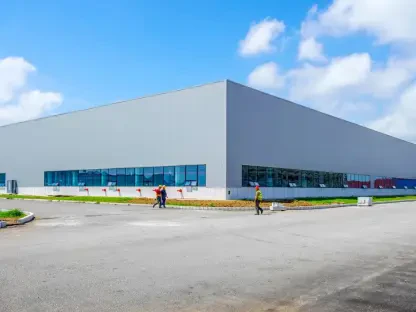Warehouse Management Systems (WMS) have become indispensable tools in modern warehouse operations, distribution centers, and inventory management facilities. As businesses strive to keep pace with faster and more unpredictable environments, the importance of these systems has grown significantly. According to Tim Macholz, Director of the Global Technology Group at Houlihan Lokey, WMS are fundamental to the orchestration and optimization of inventory movement, ensuring accuracy and efficiency in operations.
Essential Functionalities of WMS
Detailed Inventory Management
Warehouse Management Systems (WMS) provide detailed inventory management capabilities, allowing businesses to track and manage their stock with precision. This includes real-time updates on inventory levels, locations, and movements, which are crucial for avoiding overstock and stockout situations. By maintaining accurate inventory records, companies can optimize their stock levels, reduce carrying costs, and improve order fulfillment rates. Detailed inventory management further allows businesses to implement just-in-time (JIT) methodologies effectively, minimizing excess and ensuring that the right products are available at the right time.
The detailed analytics play a pivotal role in helping warehouse managers understand which products are moving quickly and which are not, enabling them to make informed decisions about restocking and obsolescence. This systematic approach not only boosts efficiency but also translates into significant cost savings by reducing waste and improving turnaround times. Additionally, precise inventory tracking enhances the capability to perform cycle counts and physical inventories without disrupting daily operations, ensuring ongoing accuracy and operational fluidity.
Order Processing and Labor Management
Order processing is another critical functionality of WMS, seamlessly streamlining the entire order lifecycle from entry to picking, packing, and shipping. This ensures that orders are processed quickly and accurately, reducing the likelihood of errors and delays. By automating several stages of order processing, WMS reduces the dependency on manual labor and minimizes the risk of human error. The system can prioritize orders based on various criteria such as delivery times or customer status, ensuring timely order fulfillment and heightened customer satisfaction.
Additionally, WMS includes labor management features that help optimize workforce productivity. The system can track employee performance and workload, providing valuable data that management can use to allocate resources more effectively. By identifying peaks and troughs in activity, businesses can adjust staffing levels to meet demand without incurring unnecessary labor costs. It also aids in setting achievable performance targets for workers and enhances overall operational efficiency.
Integration with Core Business Systems
Enhancing Data Consistency
One of the key advantages of WMS is its ability to integrate with other core business systems, such as Enterprise Resource Planning (ERP) and Transportation Management Systems (TMS). This integration ensures data consistency across the organization, providing a single source of truth for inventory and order information. With accurate and up-to-date data, businesses can make informed decisions and respond quickly to changes in demand or supply chain disruptions. The single source of truth provided by WMS integration mitigates the risk of data silos and discrepancies, streamlining communication across departments and improving overall data accuracy.
The integrated systems enable seamless communication between processes such as procurement, sales, and warehouse operations, enhancing the synchronization of activities across the supply chain. Real-time data sharing ensures that everyone in the organization has access to the same information, fostering a more transparent and collaborative working environment. This consistent approach to data management is invaluable for maintaining operational efficiency and supporting strategic planning initiatives.
Comprehensive Visibility Across the Supply Chain
Integration with other systems also offers comprehensive visibility across the supply chain, allowing companies to monitor the movement of goods from suppliers to customers. This end-to-end visibility ensures that all processes are running smoothly and helps businesses identify potential bottlenecks, optimize routes, and improve overall efficiency. By having a holistic view of the supply chain, businesses can respond proactively to disruptions, adjust their strategies in real-time, and maintain a steady flow of operations.
Comprehensive visibility across the supply chain also helps companies maintain compliance with regulatory requirements and industry standards, ensuring that protocols are followed meticulously. With access to detailed tracking information, companies can verify the provenance of their goods, manage recalls efficiently, and ensure product safety. Enhanced visibility also supports the implementation of sustainable practices by allowing businesses to monitor their environmental impact and make more informed, eco-friendly decisions.
Advanced Analytics and Reporting
Real-Time Visibility into KPIs
WMS provides advanced analytics and reporting capabilities that support real-time visibility into key performance indicators (KPIs). These analytics enable dynamic management of inventory and the warehouse floor, allowing businesses to identify trends, monitor performance, and make data-driven decisions. With real-time insights, companies can quickly address issues, optimize operations, and improve overall efficiency. The ability to track KPIs like order accuracy, order cycle time, and inventory turnover rates in real-time ensures that businesses can maintain high standards of operation and swiftly rectify any deviations from set targets.
The advanced reporting capabilities of WMS facilitate strategic planning by offering insights into long-term performance patterns and emerging market trends. Managers can utilize these insights to forecast demand, plan resource allocation, and keep pace with evolving customer expectations. By harnessing the full potential of WMS analytics, businesses can not only enhance day-to-day operations but also position themselves for sustained growth and market competitiveness.
Improved Decision-Making Capabilities
The detailed reporting capabilities of WMS also enhance decision-making capabilities by providing comprehensive data on inventory levels, order processing times, labor productivity, and other critical metrics. WMS helps businesses identify areas for improvement and implement strategies to enhance performance. This leads to increased efficiency, reduced costs, and improved customer satisfaction. Access to detailed and real-time data empowers managers to make well-informed decisions that align with organizational goals and respond deftly to market changes or internal challenges.
Enhanced decision-making capabilities also enable businesses to experiment with innovative practices, such as dynamic pricing, personalized promotions, and inventory optimization models. By leveraging data-driven insights, companies can refine their approaches to meet the specific needs of their customer base, improve service quality, and maintain a competitive edge. Ultimately, the improved decision-making facilitated by WMS translates into superior business outcomes and heightened organizational agility.
Automation and Smart Warehousing Solutions
Incorporating Automation and IoT
Technological advancements have transformed modern warehouses, driven by the rise of online shopping and changing consumer habits. WMS solutions are increasingly incorporating automation and Internet of Things (IoT) integration to enhance efficiency. Automation technologies, such as robotic picking and packing systems, reduce manual labor and accelerate order fulfillment. IoT sensors provide real-time data on inventory levels, environmental conditions, and equipment status, enabling proactive management and maintenance. These technological innovations allow warehouses to operate more efficiently while minimizing human error and ensuring optimal conditions for inventory storage and handling.
Integrating IoT devices with WMS also enhances transparency and traceability in the supply chain. For instance, by employing IoT-enabled trackers, businesses can monitor the exact location and condition of goods in transit, ensuring that products arrive as expected. This level of visibility not only improves customer satisfaction but also mitigates the risk of lost or damaged goods. Advanced IoT applications like predictive maintenance further elevate warehouse performance by identifying equipment issues before they cause significant disruptions, thereby reducing downtime and maintenance costs.
Predictive Analytics and Augmented Reality
Predictive analytics and augmented reality are also playing a significant role in modern warehouse management. Predictive algorithms help forecast demand, optimize inventory levels, and plan for future needs. Augmented reality tools guide workers through complex tasks, improving accuracy and reducing training time. These innovations empower WMS software to manage warehouses more intelligently, improving efficiency and responsiveness to dynamic supply chain demands. Predictive analytics allow businesses to anticipate market trends and adjust their inventory strategies accordingly, ensuring that they are always prepared to meet customer demands without overstocking.
Augmented reality (AR) applications, on the other hand, enhance worker productivity and accuracy by providing real-time visual guidance for tasks such as picking and packing. Workers equipped with AR devices can quickly locate items, follow optimal picking routes, and ensure that orders are fulfilled correctly. This minimizes errors and reduces the need for extensive training, as the AR tools provide step-by-step instructions for even the most complex tasks. By integrating these advanced technologies, WMS solutions enable warehouses to operate more efficiently and adapt swiftly to changing market conditions.
The Role of AI in Warehouse Management
Generative AI and Advanced Functionalities
Generative AI is a burgeoning influence within modern warehouses, with tools like ChatGPT and Google Bard reshaping the technology landscape and making sophisticated AI functionalities more accessible. Generative AI can be integrated into WMS to offer new possibilities, such as interactive training, intuitive user interfaces, advanced reporting, improved workflows, and enhanced demand planning. These AI-driven capabilities help businesses stay ahead of changing consumer habits and maintain competitiveness. For example, interactive training modules powered by AI can provide personalized learning experiences for employees, accelerating their proficiency and reducing onboarding times.
Moreover, intuitive user interfaces driven by generative AI make WMS more user-friendly, enabling workers to navigate systems effortlessly and perform tasks efficiently. Advanced reporting capabilities powered by AI offer deeper insights into operational performance, identifying areas for improvement and optimizing resource allocation. Generative AI also enhances workflow automation by streamlining repetitive tasks, freeing up human resources for more strategic activities. Collectively, these functionalities significantly boost warehouse efficiency and productivity.
AI-Powered Drones and Predictive Maintenance
SOTI is harnessing AI to develop self-navigating drones for warehouse use, providing a cutting-edge solution for locating people, objects, and packages automatically. AI-powered intelligence helps predict and prevent device issues, automate repetitive tasks, and support inventory management and demand forecasting. By leveraging AI technologies, warehouses can enhance operational efficiency, reduce downtime, and improve overall performance. These drones, equipped with sophisticated AI algorithms, navigate through warehouse aisles independently, performing tasks such as stocktaking and locating lost items with precision and speed.
Predictive maintenance powered by AI further enhances warehouse management by anticipating equipment failures and scheduling maintenance proactively. This reduces unexpected downtimes and extends the lifespan of machinery, leading to cost savings and uninterrupted operations. Additionally, AI-driven predictive maintenance ensures that all equipment functions at optimal efficiency, preventing gradual performance degradation over time. The integration of AI technologies in warehouse operations represents a significant step toward smarter, more resilient, and highly efficient supply chain management practices.
Benefits of a Well-Functioning WMS
Improved Efficiency and Accuracy
Warehouse Management Systems (WMS) have evolved into crucial assets for modern warehouse operations, distribution centers, and inventory management facilities. In today’s fast-paced and often unpredictable business environment, the value of these systems cannot be overstated. As companies aim to meet the demands of quicker and more volatile markets, the importance of WMS has grown exponentially.
Tim Macholz, Director of the Global Technology Group at Houlihan Lokey, emphasizes that WMS are essential for the coordination and enhancement of inventory movement. These systems ensure that operations run smoothly and efficiently, maintaining accuracy throughout the process. By automating and optimizing various warehouse functions—such as receiving, storage, picking, and shipping—WMS help businesses reduce human error and improve productivity.
Furthermore, WMS provide real-time data and analytics, which enable managers to make informed decisions and adjustments. This agility is vital for maintaining competitiveness in an ever-evolving market. Integrating WMS with other technologies, such as Transportation Management Systems (TMS) and Enterprise Resource Planning (ERP) systems, further streamlines operations and provides a holistic view of the supply chain.
In summary, the role of WMS in modern warehouse and inventory management cannot be overlooked. They are pivotal in ensuring that businesses can respond swiftly and efficiently to market demands, ultimately contributing to overall operational success.









